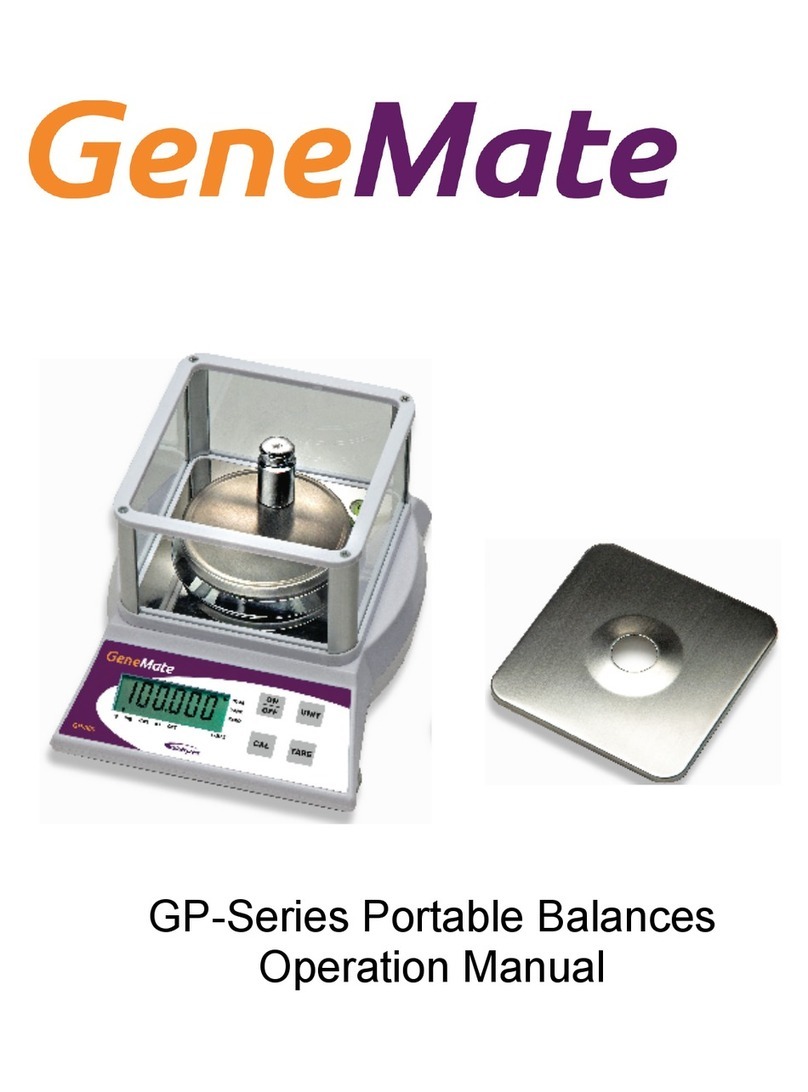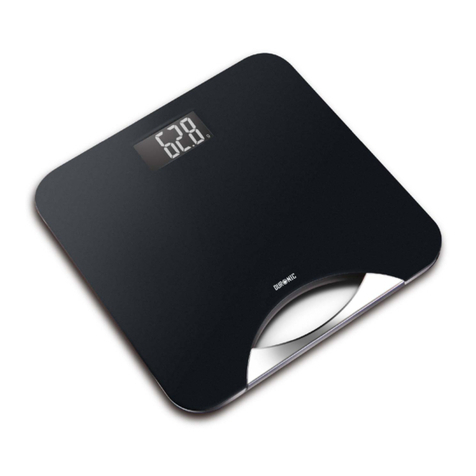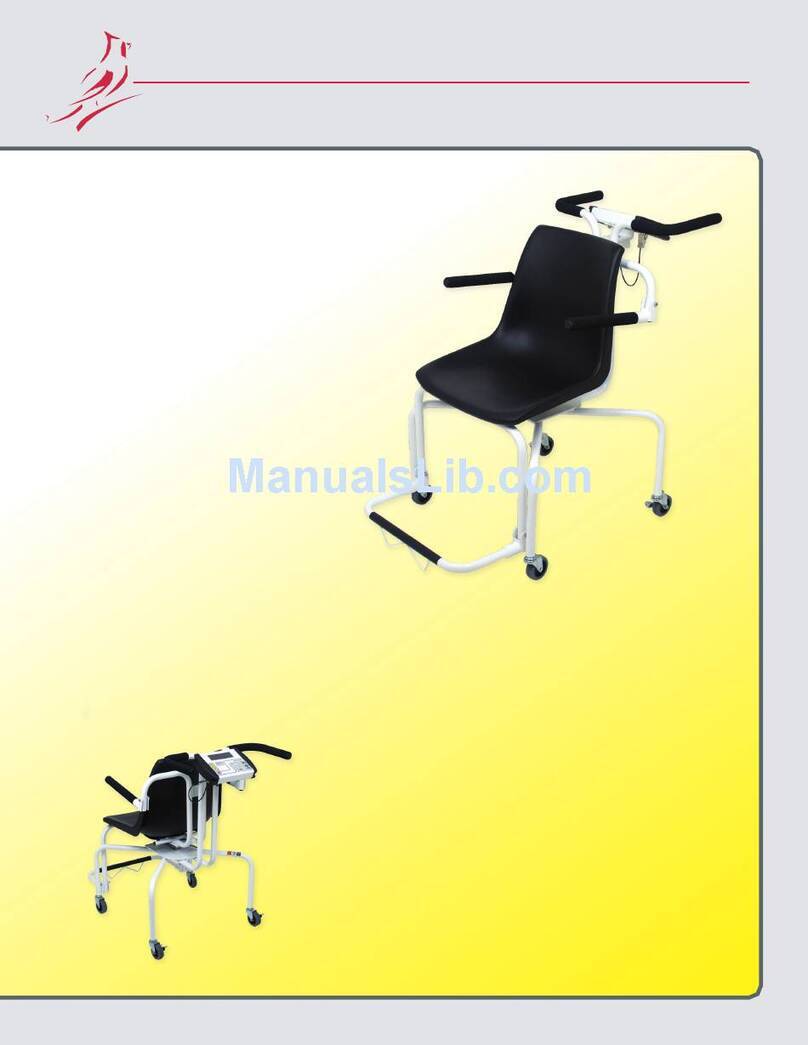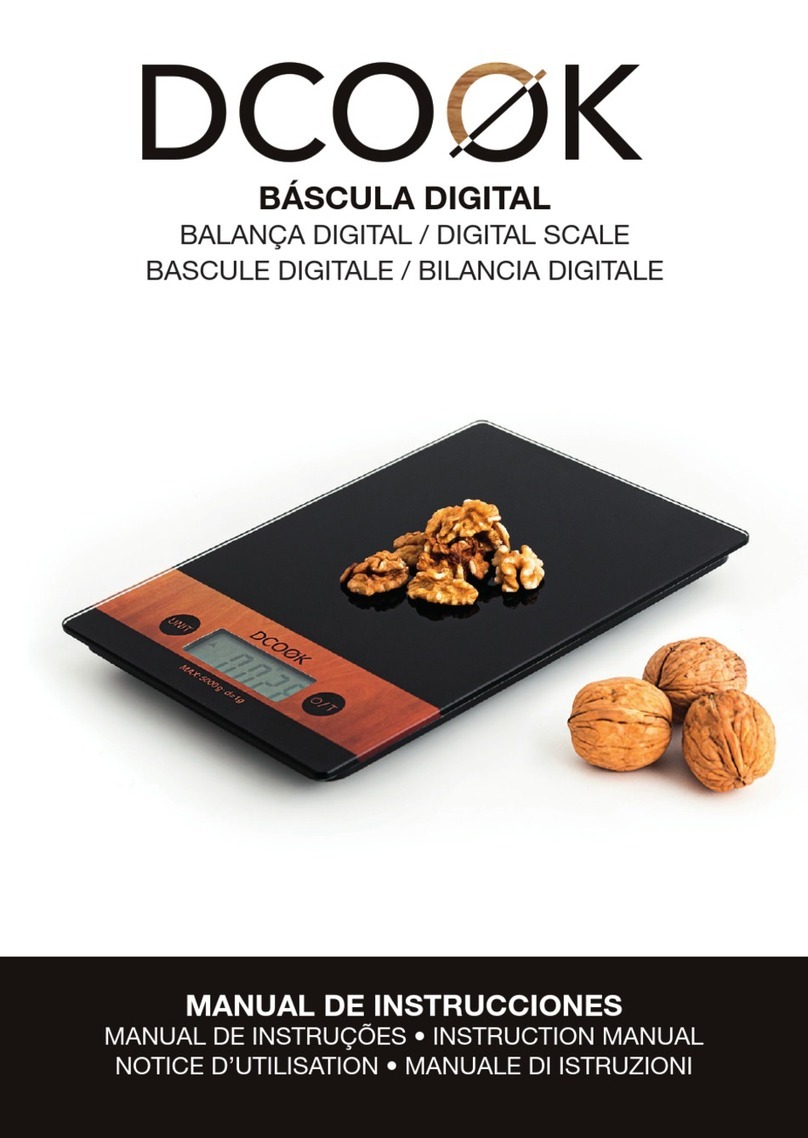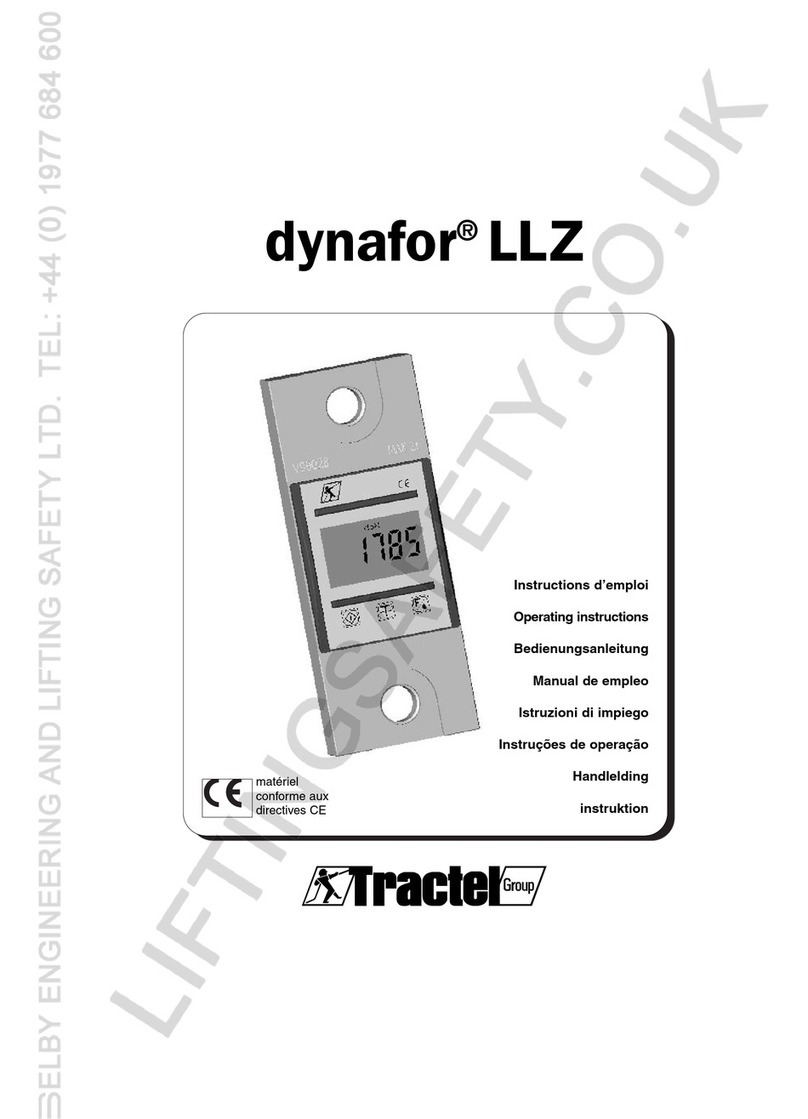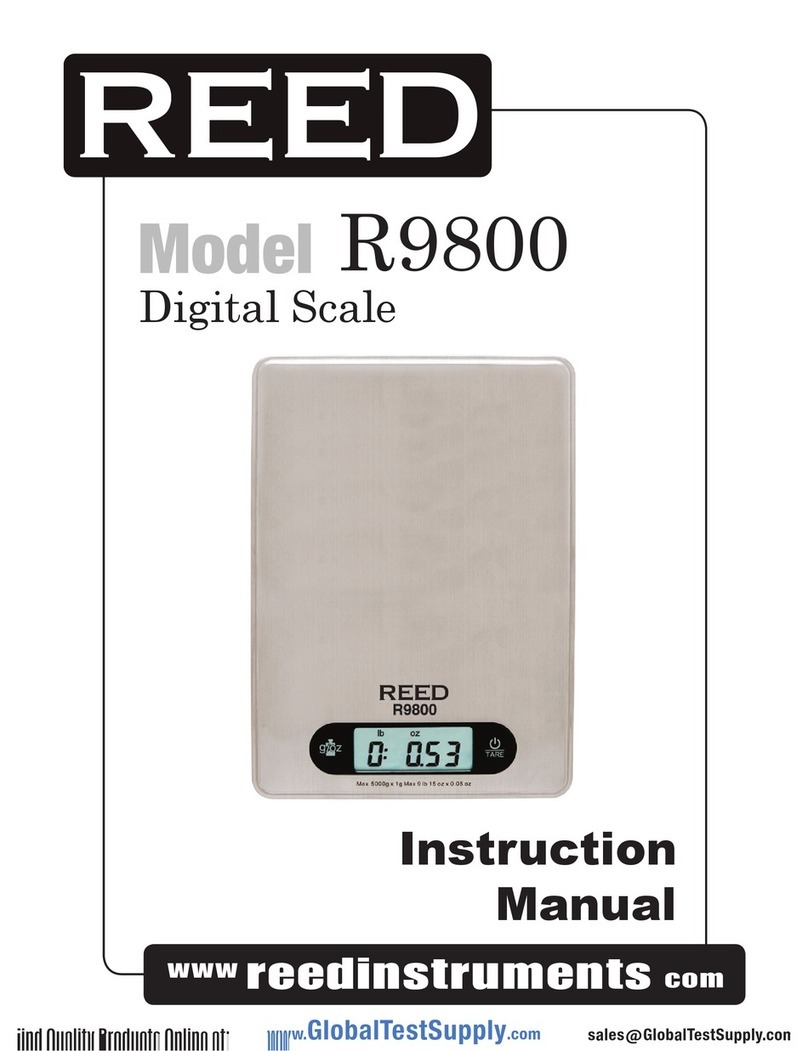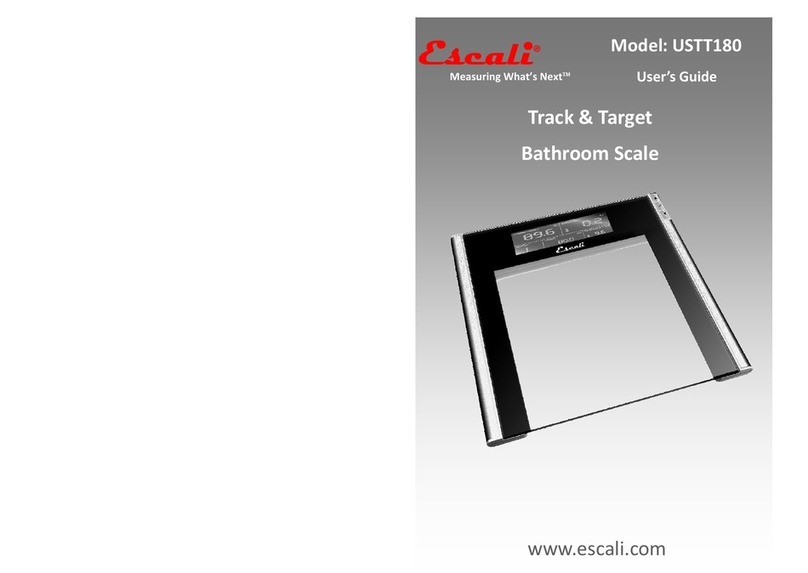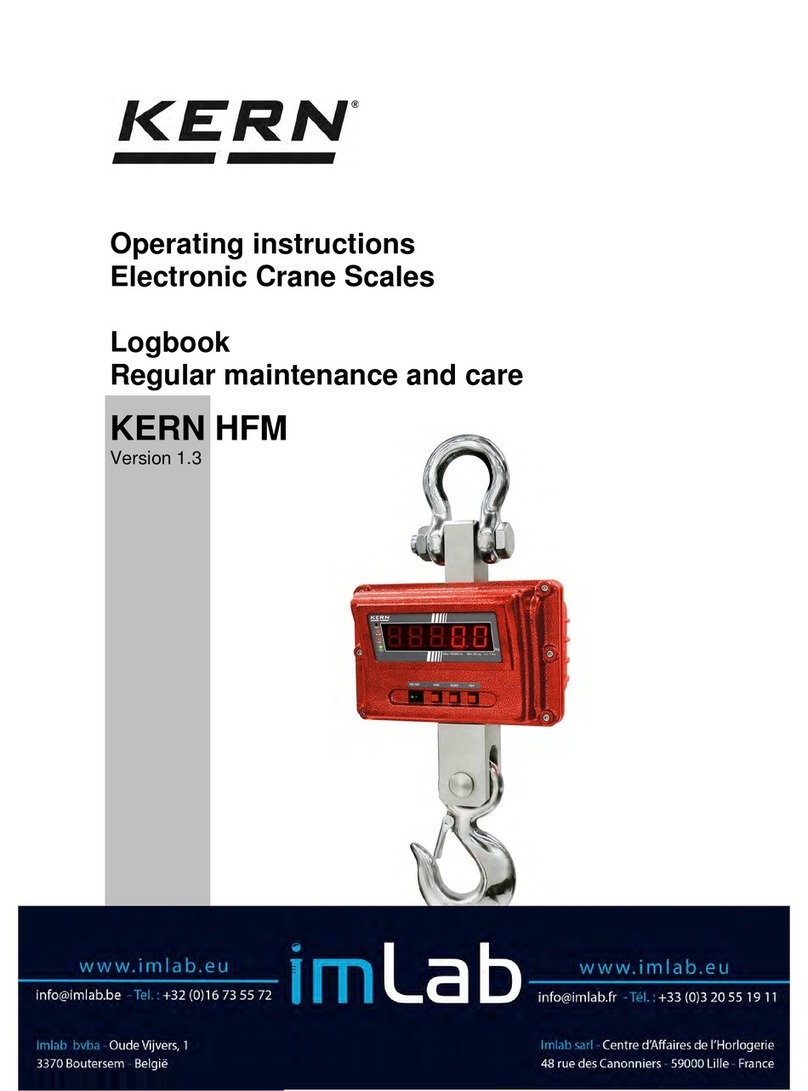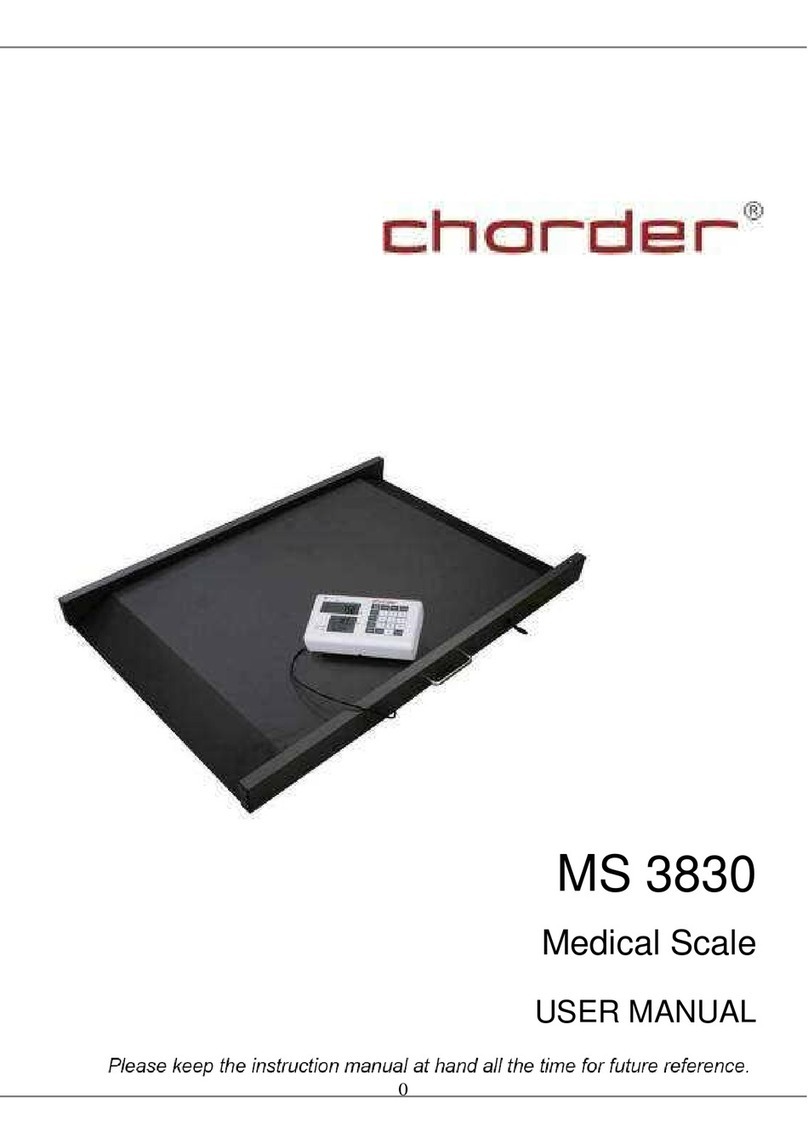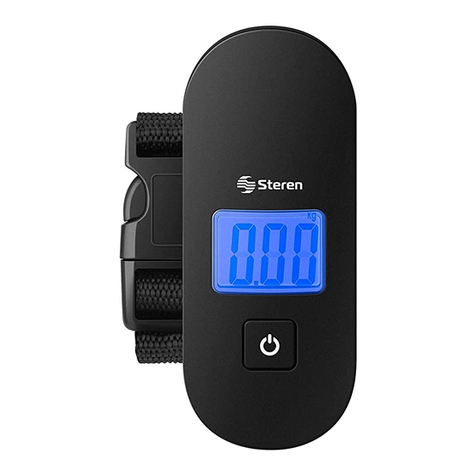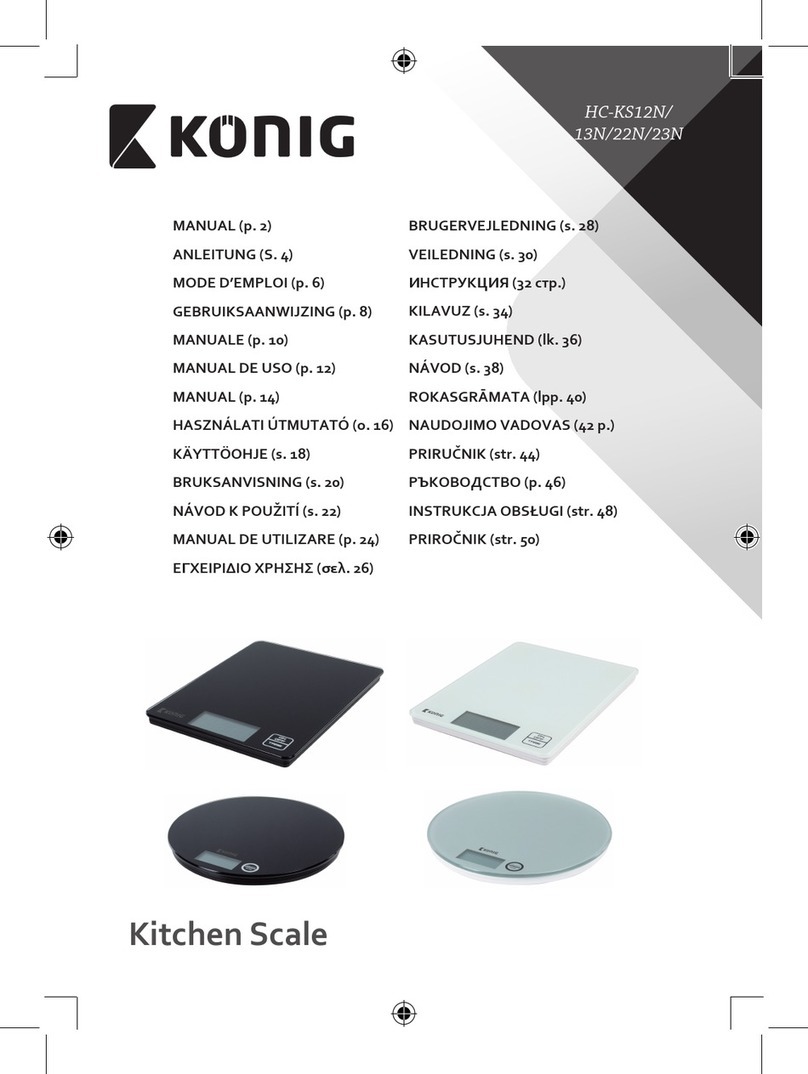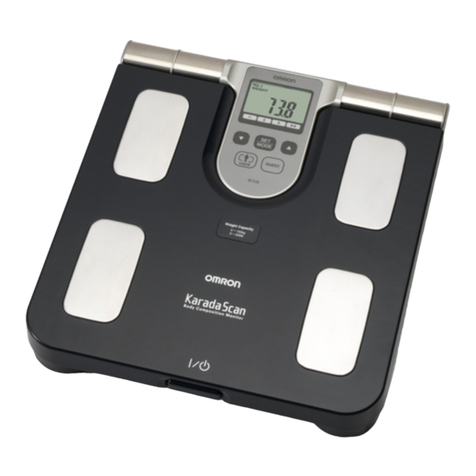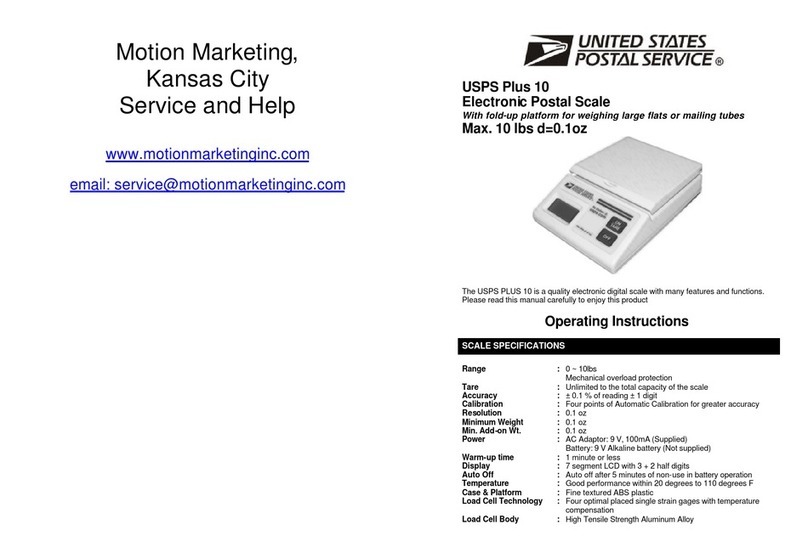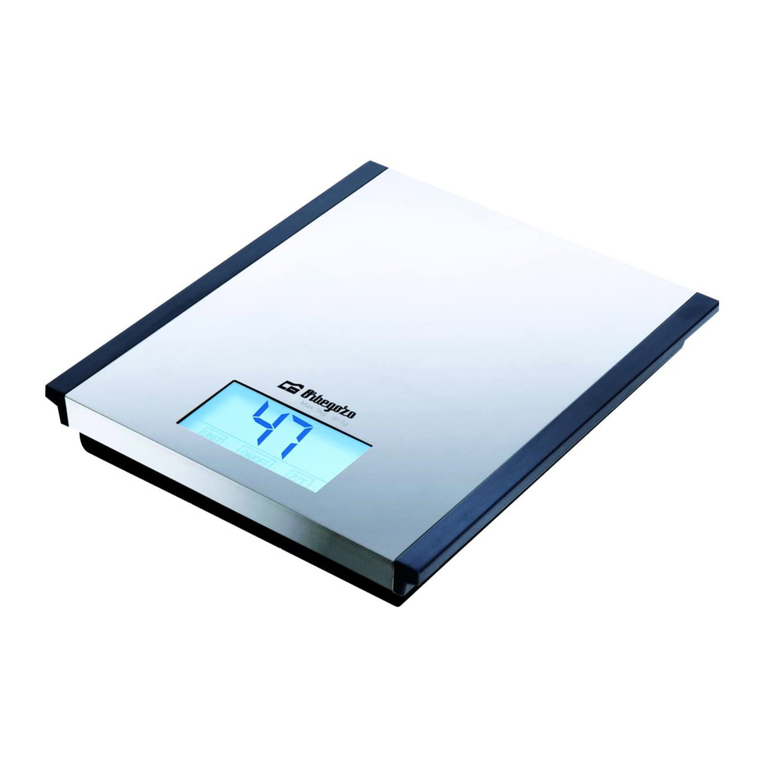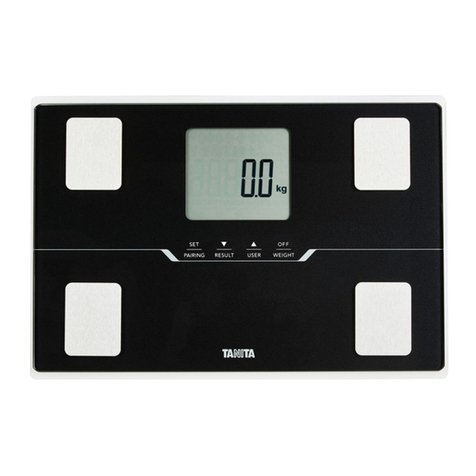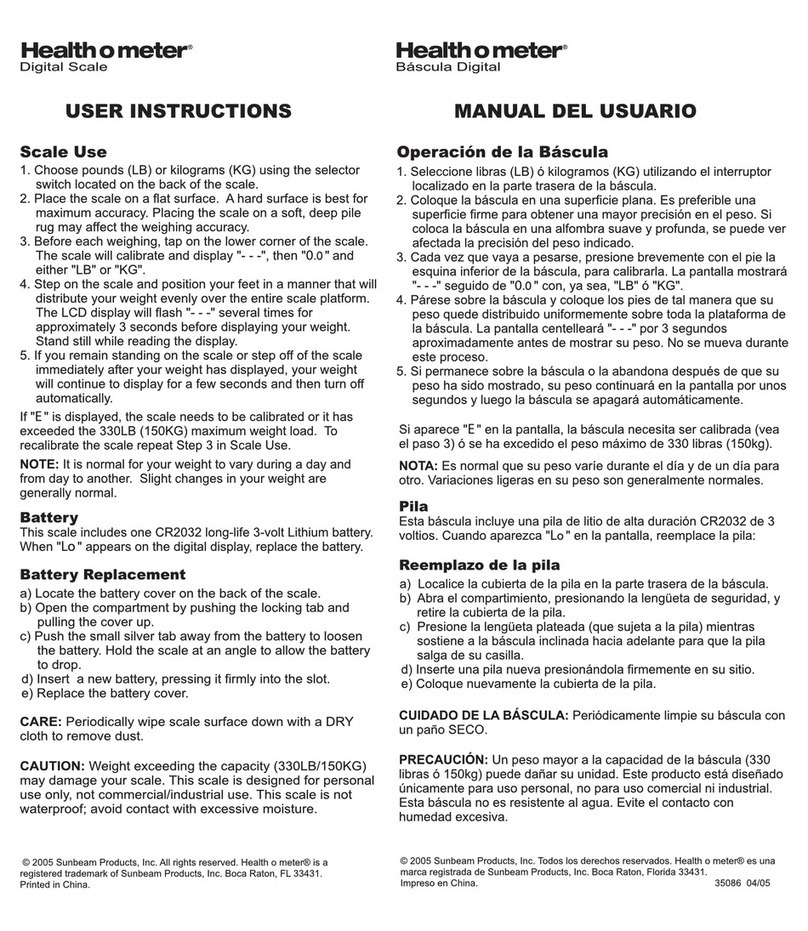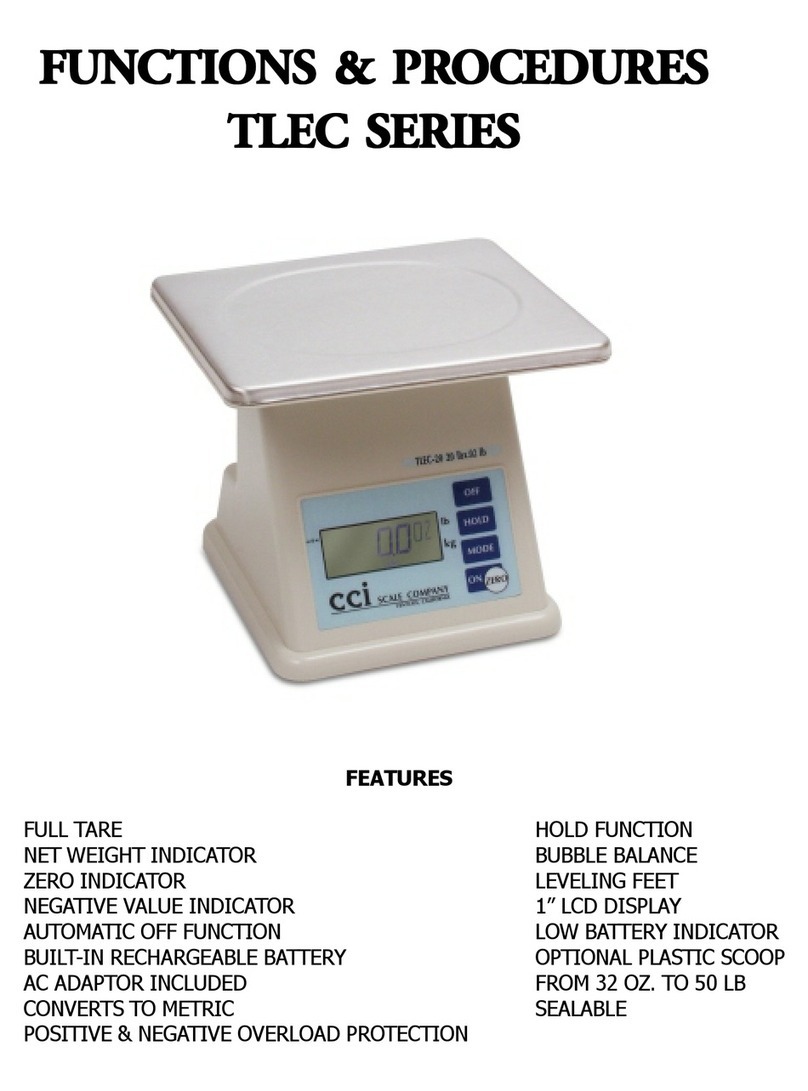GeneMate GM Series Balances User manual

GM-Series Balances
Operation Manual

TABLE OF CONTENTS
SAFETY PRECAUTIONS……………….……………………………………………………………………………. 1
GETTING STARTED…..…………….……………………………………………………………………………….1
INSTALLATION & SET-UP……..………………………………………………………….………………………. 2
POWER CONNECTION………….……………………………………………………..…………………………… 3
ANTI-THEFT DEVICE…………………………………………………………………..………….………………… 3
LEVELING..…………………………………………………………………….……………………………………… 3
CALIBRATION…..……………………………………………………….…………………………………………… 4
TARE FUNCTION.……………………………………………………….…………………………………………… 4
GOOD WEIGHING TECHNIQUE…………………………………….…………………………………………… 5
DISPLAY OVERVIEW......................................................….....………………………………………………… 6
PROGRAMMING INSTRUCTIONS…………………………….………………………………………………… 7
WEIGHING PROGRAMS
Basic Weighing Mode.……………………………………………..…………………………………... 7
Multiple Weigh Mode.............…………………………………………….…………………………… 7
Percent Weighing Mode........…….……………………………………..……………………………… 7
BALANCE SETTINGS
Ambient Conditions (Electronic Filter) Settings……………………..…………………………… 8
Auto Zero Setting……….......…….………………………………………..…………………………… 8
Audible Key Tone Settings..…….………………………………………..…………………………… 8
DATA INTERFACE SETTINGS...….……………………..…..……………………………………….…………… 9
PROGRAMMING MENU CODES – QUICK REFERENCE GUIDE….………………………….…………….10
CARE & MAINTENANCE….……………………………………………………………………………………….. 11
ERROR MESSAGES & TROUBLESHOOTING GUIDE.…..……………………………………….…………… 11
SERVICE & TECHNICAL SUYPPORT…...…………………..………………………………………….………… 12
DISPOSAL……………………………….…...…………………..………………………………………….………… 12
CE COMPLIANCE AND MARKING………………………....………………………………………….………… 12
SPECIFICATIONS…………………………………………...…..…………………………………………….……… 13
INSTRUMENT DIAGRAM………………………………...…..…………………….……………………………… 14
i

Congratulations and thank you for selecting a GeneMate GM-Series Balance. Your balance was designed
and manufactured to give you years of service.
SAFETY PRECAUTIONS
- Check the instrument for any visible signs of damage before you apply power.
- Ensure the power supply is compatible with your instrument AND the local line voltage.
- Do NOT operate in Hazardous Locations. Consult your Safety Officer with any questions or
concerns.
- Make sure no liquid enters the housing. Use a damp cloth to clean the instrument.
- Do not locate in areas where corrosive gases are present.
- Avoid exceeding/overloading the weigh capacity or dropping samples onto the weigh pan.
Weight overload and shock may damage the instrument and void the warranty
- Connect only accessories and options that are designed for use with your balance. The
operator shall be responsible for any modifications to the equipment and for any connection of
cables, power supplies or peripheral equipment that are not compatible with GM Series Balances.
-Unplug the balance from AC power before you connect or disconnect a peripheral device (Printer or PC) to or
from the interface port
-The only way to completely turn off the electrical source is to disconnect the power cord.
If there is any indication that safe operation of the balance is no longer certain:
-Turn off the power and disconnect the equipment from AC power immediately.
-Lock the equipment in a secure place to ensure that it cannot be used for the time being.
-Notify the nearest Service Center. A trained service technician must perform repair work.
GETTING STARTED
Check the contents of your shipping carton for the following:
-GM-Series Balance
-Weigh Pan
-Pan Support (B-1850-20, -60, -120, -210, -200, -400, -500, -1000, -4000 & -5000)
-Draft Ring (B-1850—20, -60, -120, -210, -200, -400, -500 & -1000)
-Dust Guard (B-1850-20, -60, -120, -210, -200, -400, -500 &-1000)
-Operation Manual
-Power Supply
Please read your operation manual and follow the instructions for installing your balance. Please keep your
packaging for future transport and remember to return your Warranty Card.
Page 1

INSTALLATION & SETUP
- Choose a location that is free from the influences of the following:
-Drafts: Fans, Heat/Air Duct, Doorways or High Traffic Areas.
-Vibrations.
-Extreme Temperature Fluctuations: Sunlight, Ovens, or Environments with Wide Temperature Variations.
-Voltage Fluctuations. Do Not Share Current with Other Instruments that Draw Voltage in an Inconsistent
Manner such as Fluorescent Lights, Centrifuges and the like.
- Place Instrument on a Level, Rigid Surface.
- Level the Instrument.
- Allow 60 Minutes for Warm-up.
- Calibrate. All GM-Series are calibrated at the factory prior to shipment. Transportation of the instrument plus
the differences in barometric pressure, humidity and ambient temperature conditions require calibration at the
point of use. Calibrate regularly, at least once a week, to ensure accurate weighing results.
Place components inside the chamber in the following order
(Models B-1850-20, -60, -120, -210, -200, -400, -500 &-1000)
-Dust Guard
-Draft Ring
-Pan Support
-Weighing Pan
Place weigh pan on balance (Models B-1850-4000 & B-1850-5000)
Page 2

AC POWER CONNECTION
- When connecting power use the original AC adapter supplied with the balance. Using an unapproved power
supply may damage the instrument and void the warranty.
- Ensure the power supply is compatible with your instrument AND the local line voltage.
- Connect the plug to the instrument.
- Connect adapter to the power outlet.
- Original Power Supply:
Input: 100-240VAC, 50-60Hz, 0.6A
Output: 15VDC, 1A
Polarity: Inside = -, Outside = +
Antitheft Locking Device
To protect against theft place a cable through the built-in security device located on the back of the balance next to
the leveling bubble and connect to a fixed point; secure with a lock.
Leveling the Balance
A slight unevenness in a balance will result in an inaccurate measurement. For accurate calibration and weighing
results level the balance at installation and any time the instrument is moved to a new location.
Only the 2 front feet are adjusted to level all GM-Series balances. Turn the 2 front feet as shown in the diagram
until the level bubble (located on the back of the balance) is centered within the circle of the level indicator.
△In most cases leveling the balance will require several adjustment steps.
Page 3

CALIBRATION
Calibration is required at installation (see Installation & Set-up) and at regular intervals thereafter. Calibrate if the
balance is moved to a new location.
1. Allow a 60-minute warm-up period.
2. Press Tare to zero the balance (0.0000g) – if required.
3. Remove all items from weigh pan.
4. Ensure that you are in the gram (g) weigh mode.
5. Press CAL Key once. The preprogrammed calibration weight value for the balance will appears on the display,
ie: 100.00 (B-1850-120) and “flash”. Place the appropriate calibration weight (gram) for your balance (see chart
below) within 2 Seconds.
8. When calibration is complete the balance will beep and display Cal-End and then return to the weigh mode.
Calibrate on a regular basis, we recommend once a week, or more.
If the above conditions are not met an error message will appear on the display. See Error Messages and
Troubleshooting Guide, page 11.
Calibration Weight Values*
B-1850-20 20g OIML E1
B-1850-60 50g ASTM Class 1
B-1850-120 100g ASTM Class 1
B-1850-214 200g ASTM Class 1
B-1850-200 200g ASTM Class 1
B-1850-400 200g ASTM Class 1
B-1850-500 500g ASTM Class 1
B-1850-1000 1000 OIML E2
B-1850-4000 2000g ASTM Class 1
B-1850-5000 5000g ASTM Class 1
* Class 1 or Better
TARE FUNCTION
TARE is defined as net weight. Should you wish to use a beaker, flask or some other container for your sample
simply place the container on the weigh pan and press the TARE KEY once. Please note that any container that is
“tared” will decrease the remaining capacity available on the balance by the weight of the container. If you do not
use a container for weighing verify the reading is "0" before placing a sample on the weigh pan. If not, press TARE
KEY to display "0".
Page 4

Good Weighing Technique
Working with precision balances requires a steady hand and an even, uninterrupted technique. Use forceps or other
suitable utensils to place the sample (and sample container) on the weigh pan as fingers are hygroscopic.
If the balance has been idle and the draft chamber doors closed for an extended period, perform a number of test
measurements before you begin weighing to allow the atmospheric conditions (temperature, RH and barometric
pressure) inside the weighing chamber to adjust to the ambient temperature outside the chamber. Rapid changes
in atmospheric conditions will have an adverse effect on the weighing result. A series of test measurements will
also help develop a smooth working rhythm. Ensure the sample and container have acclimated to the ambient
temperature of the instrument in use. Place the sample gently on the weighing pan, in the center.
Use the smallest sample container possible to reduce the influence of laminar air movement. When working with
aqueous solutions select a sample container with a small opening to minimize the effect of evaporation. Cover the
container opening when working with light volatiles.
Static electricity may have an adverse effect on weighing results such as drift and non-repeatability. When
working with samples or containers with low conductivity properties, you can optimize the performance of the
balance by:
!Shield the Sample from the Weigh Pan (Metal Container and /or Foil)
!Use Anti-static Device (Brush or Ionizer)
!Increased Ambient Humidity Levels
!Anti-static Weigh Containers
Avoid weighing magnetically charged (ferrous) materials such as ion, nickel and ion. To minimize the effects
(non-repeatability) of ferrous material:
!Demagnetize the Sample
!Increase the Distance of the Sample from the Weigh Pan
!Use Below Pan Weighing (Weigh-below) Procedure
A good working knowledge of the effects from the various environmental conditions, sample matrices, container
profiles and weighing technique is paramount for high precision weighing. Preventative measures to minimize the
effects of these conditions will provide you with optimal weighing results from your balance.
Page 5

DISPLAY OVERVIEW
(1)(3)(5)
00000.000g
(2) (6)(4) (2)
Key Pad # Function
1 On / Off Key
2 Tare Keys (Right & Left Sides)
3 Calibration Key
4 Mode Key:
g, lb, oz, ct, mg or kg, ozt, dwt, gn, Percent (%), Count & Animal Weigh
Milligram (mg) Mode (0.01mg, 0.1mg & 0.001g Models)
Kilogram (kg) Mode Key (0.01g Models)
5 Print (Data Send) Key
6 Stability Indicator
Page 6

PROGRAMMING INSTRUCTIONS
The GM-Series offers several Weigh Modes, Balance Settings and Interface Options. Weigh Modes include Gram
(g) Milligram (mg) / Kilogram (kg) and Percent Weighing. The GM-Series also offers adjustable settings for Auto
Zero, Baud Rates, Print (data send) Commands, Electronic Filtering and Audible Key Tone functions.
To access the Weigh Modes simply Press Mode Key to scroll between g, lb, oz, ct, mg or kg, ozt, dwt, gn, Parts
Counting, Percent Weighing (%) and Animal Weigh. Please see Display / Keypad Diagram. To access and adjust
the Program Settings of your choice, please following the instructions listed below:
Step Display
1. Press On / Off Key to Turn Balance Off. Blank (w Stand-by Power Indicator On)
2. Press Print Key Twice. C1 - - 0
3. To “advance” to the next Program Setting or Interface Option
Press Print Key.C2 - - 0, C3 - - 0, C4 - - 0, etc.
4. To “adjust” a Program Settings or Interface Option Press Mode
Key (Example: Auto Zero) C3 - - 0, C3 - - 1, C3 - - 2, etc.
5. To Save Programming Settings Press ON / Off Key Blank (w Stand-by Power Indicator On)
6. Press On / Off Key to Turn Balance On and Return to the
Weigh Mode. 0.0000
WEIGHING PROGRAMS
1) Basic Weighing Mode (g, mg/kg)
Once installation and calibration have been completed the GM-Series is ready to weigh. Simply place a
sample on your weigh pan and the result will appear on the display. Response (stabilization) time on the
GM-Series is 3 seconds, average. When the balance has reached stability, an icon will appear on the left hand
side of the display. Gram (g) is the factory default setting. To select another unit of measure, Press the Mode Key
until the desired mode of measurement (g, lb, oz, ct, mg or kg, ozt, dwt, gn) appears in the display.
2) Percent Weighing Mode
Percent Weighing mode allows the user to obtain values in a percentage that are proportional to an initial
reference weight. To activate the Percent Weighing function simply Press the Mode Key until the mode indicator
Percent (%) appears on the display. Once you have selected the Percent Weighing Mode place the reference
sample on the weigh pan and Press CAL Key to assign the reference sample a value of 100%. If you would like to
use a sample container, remove the reference sample, place the container on the balance and Press Tare Key.
Place your sample into the container) and the percentage value will appear on the display. Example 50%.
3) Parts Counting Mode
In addition to weighing samples, GM-Series balances have the ability to “count” parts. For the best results
please ensure that you have selected a balance with the proper resolution for your smallest part and that the parts
are approximately equal in weight. For example, if you wish to count a 500 parts at a time that weigh 0.001g per
part you should use a balance with 0.001g (or greater) resolution. In addition, you should select the highest level of
Initial Sample Size (i.e.: 100) to ensure an accurate average piece weight as a reference. The factor default setting
for Initial Sample Size is Ten.
Page 7

There are five Initial Sample Setting Options (see below). Follow the Programming Instructions listed above to
adjust the Initialize Size that is appropriate to your sample. Once you have selected the Initial Sample Size Press
the Mode Key until the COUNT appears on the display. Place the reference pieces on the weigh pan and Press
CAL Key to assign the reference sample a value of your parts. If you would like to use a sample container, remove
the reference sample, place the container on the balance and Press Tare Key. Place your parts into the container
and the number of parts (count) value will appear on the display. Example 100.
Sample Size Settings
Ten (10) C2 - - 0
Twenty (20) C2 - - 1
Twenty (50) C2 - - 2
Fifty (50) C2 - - 3
One Hundred (100) C2 - - 4
One Thousand (1000) C2 - - 5
BALANCE SETTINGS
1) Ambient Condition (Electronic Filtering) Setting
All GM-Series have an adjustable Ambient Condition (electronic filter) setting. This feature allows you to
adjust the balance to optimize performance in less-than-ideal environments. For most applications and
environments the factory default setting (C7 - - 1) should provide optimal performance (stability and speed of
response). If your environment is not ideal for good weighing performance you may improve the performance by
adjusting an Electronic Filter Setting that is better suited for your environment. If adjustment to the electronic
filtering does not improve the performance of your balance (stability & response time) you should move the
instrument to a location better suited to precision weighing (see Installation & Set-up, page 2 and Good Weighing
Technique, page 5).
Electronic Filter Settings
No Filtering – Very Stable Environment C7 - - 0
Limited Filtering – Good Environment C7 - - 1*
Moderate Filtering - Poor Environment C7 - - 2
Strong Filtering – Very Poor Environment C8 - - 3
2) Auto Zero Setting
GM-Series come with an adjustable Auto Zero Setting. The Factory Default Setting is C3 - - 5, 5 Counts /
Divisions. However, you may adjust the counts / divisions or deactivate the Auto Zero Function by simply entering
the programming code listed below following the Program Instructions provided on page 7.
Auto Zero Settings
Auto Zero, 0 Divisions (Off) C3 - - 0
Auto Zero, 1 Division C3 - - 1*
Auto Zero, 2 Divisions C3 - - 2
Auto Zero, 3 Divisions C3 - - 3
Auto Zero, 4 Divisions C3 - - 4
Auto Zero, 5 Divisions C3 - - 5*
Page 8

3) Audible Key Tone Setting
GM-Balances come with an adjustable Audible Key Tone Setting. The factory default setting is on. However, you
may disable the Audible Key Tone by following the Programming Instructions listed on page 7.
Audible Key Tone Settings
Always Off C6 - - 0
Always On C6 - - 1*
DATA INTERFACE SETTINGS
All GM-Balances come with RS232 interface connection. To adjust the Data Interface Settings (Baud Rate, parity
& Print Command) enter the appropriate programming codes listed on page 13 using the programming instructions
provided on page 7. Please note that Data Collection Software is required to collect weighing data sent from the
balance. Contact your dealer for information on printers and data collection software.
General Specifications:
Interface: Serial
Operation: Asynchronous, Full Duplex
Standard: RS232
Handshake: CTS = Clear to Send
DTR = Data Terminal Ready
Character Coding: 8-bit ASCII
Character Format: 1 Start Bit
7-bit ASCII
Parity: None
1 Stop Bit
Data Output Format; Balance: 16 Characters
Data Bits:7-bit ASCII
Synchronization: 1 Start Bit; 1 Stop Bit
Display: Stable + 10.0000 g
Unstable 10.0001kkkg
Connector: DB9
BALANCE PC
TXD 2------------------------------ 2 RXD
RXD 3------------------------------ 3 TXD
SG 5------------------------------ 5 SG
Baud Rate
2400 Baud* C4 - - 0
1200 Baud C4 - - 1
4800 Baud C4 - - 2
9600 Baud C4 - - 3
Print/Send Data
Manual, At Zero with Stability C5 - - 0
Manual with Stability C5 - - 1
Manual with Stability* C5 - - 2
Continuous (0.3 Seconds) without Stability C5 - - 3
Page 9

PROGRAMMING MENU CODES – QUICK REFERENCE GUIDE
Code Function
C1 Parts Counting
C1 - - 0* Sample Size = 10
C1 - - 1 Sample Size = 20
C1 - - 2 Sample Size = 50
C1 - - 3 Sample Size = 100
C1 - - 4 Sample Size = 1000
C2 Reserved – No Function
C3 Auto Zero
C3 - - 0 Auto Zero Off
C3 - - 1 1 Count / Division
C3 - - 2 2 Counts / Divisions
C3 - - 3 3 Counts/ Divisions
C3 - - 4 4 Counts / Divisions
C3 - - 5* 5 Counts/ Divisions
C4 Baud Rate
C4 - - 0* 2400 bps
C4 - - 1 1200 bps
C4 - - 2 2800 bps
C4 - - 3 9600 bps
C5 Print (Data Send)
C5 - - 0 Automatic at Zero w Stability
C5 - - 1 Automatic at Stability
C5 - - 2* Manual at Stability
C5 - - 3 Continuous
C6 Audible Key Tone
C6 - - 0 Off
C6 - - 1* On
C7 Ambient Condition (Electronic Filtering)
C7 - - 0 No Filter -Very Stable Environment
C7 - - 1* Limited Filter - Good Environment
C7 - - 2 Moderate Filter - Poor Environment
C7 - - 3 Strong Filter - Very Poor Environment
See Pages 2; Installation & Set-up and Good Weighing Technique before adjusting the electronic filter settings.
C8 Model Information at Power ON
C8 - - 0 On
C8 - - 1 Off
C8 - - 2 Standby
* Factory Default Setting
Page 10

CARE & MAINTENANCE
!Unplug the instrument from the power source – wall outlet.
!Wear appropriate safety protection.
!Clean inside hood when appropriate. A damp cloth is recommend for basic cleaning. Do not use solvents
on the instrument housing, sub-pan, keypad, power cord and power jack.
!Make sure no liquid enters the instrument housing.
!Handle with care to avoid damage to the weigh cell.
!Consult your safety officer with any questions or concerns.
ERROR MESSAGS & TROUBLESHOOTING GUIDE
Error codes appear on the display for 2 seconds. The program then returns automatically to the weighing mode.
Display
Cause
Solution
No Segments on the
Display
No AC Power
The Power Supply is not
Plugged into the Balance
Blown Fuse
Check the AC Power Supply
Plug in the Power Supply
Replace Fuse
E _ _ _ _
The Weight Value Exceeds
the Capacity of the Balance
Remove Load from the
Weigh Pan
- E _ _ _ _
(Under Load Indicator)
Improper Assembly of
Weigh Pan and Sub Pan
Assembly
Remove Weigh Pan, Sub
Pan and Reassemble
Err - - 0
&
Err - - 1
Calibration Failure
Environmental Factors
Causing Unstable
Conditions. Move to a More
Suitable Location (see pages
2 and 5)
Inappropriate Calibration
Weight. Initiate Calibration
Procedure with Correct
Calibration Weight
Page 11

SERVICE AND TECHNICAL SUPPORT
If you have ANY questions or require technical, application or service support please contact BioExpress at
800-999-2901.
Please note that BioExpress and affiliates cannot take back any instrument that has been exposed to biological or
hazardous material contamination for replacement, credit, repair or disposal.
DISPOSAL
Please consider the environment when disposing of your instrument and the packing material. Please recycle all
environmentally friendly waste. Please contact your local government agency, facilities manager or a commercial
disposal operator on the proper disposal of the instrument and power supply.
CE Compliance & Marking
This instrument complies with European Standards and EC Directives:
Electromagnetic Compatibility (EMC) Council Directive 89/336/EEC
Applicable European Standards:
Limitation of Emissions in accordance with standard EN 61326-1 Class B for residential areas.
72/23/EEC “Electrical Equipment Design within Certain Voltage Limits”
Applicable European Standards:
EN 60950
Safety Requirements for electrical equipment for measurement, control and laboratory use Part1: General
requirements.
Note:
Modification of this instrument in any manner is the sole responsibility of the owner/operator. In addition to voiding
the warranty, the owner/operator is responsible to check and if necessary correct any modifications required in
accordance to the standards listed above for immunity to interference. Operating standards for this instrument
are available upon request.
Page 12

SPECIFICATIONS
Model
Capacity
Readability
Linearity
Tare Range
B-1850-20
20g
0.01mg
0.03mg
0 to 20g
B-1850-60
60g
0.1mg
0.2mg
0 to 60g
B-1850-120
120g
0.1mg
0.2mg
0 to 110g
B-1850-210
210g
0.1mg
0.2mg
0 to 210g
B-1850-200
200g
0.001g
0.002g
0 to 200g
B-1850-400
400g
0.001g
0.002g
0 to 400g
B-1850-500
500g
0.001g
0.002g
0 to 500g
B-1850-1000
1000g
0.001g
0.002g
0 to 1000g
B-1850-4000
4000g
0.01g
0.02g
0 to 4000g
B-1850-5000
5000g
0.01g
0.02g
0 to 5000g
Common Specifications:
Pan Size:
B-1850-20, -60, -120, -210, -200, -400 & -500 90mm (3.5in)
B-1850-1000, 4000 & -5000 (W x L) 160mm (6.3in)
Stabilization Time:
B-1850-20 5 Seconds (average)
All Other Models 3 Seconds (average)
Operating Temperature: 5C to 40C (41-104F)
Power Requirements:
Input: 100- 240VAC, 50-60 Hz, 0.6A Output 15DC, 1.0A
Polarity: Inside = Negative (-) Outside = Positive (+)
Unit Dimensions: (L x w x H)
B-1850-20, -60, -120, -210, -200, -400, -500 &-1000 335 x 213.5 x 293mm (13.2 x 8.4 x 11.5in)
B-1850-4000 & -5000 335 x 213.5 x 94.5mm (13 x 7.9 x 3.7in)
Internal Chamber Dimensions:
B-1850-20, -60, -120, -210, -200, -400, -500 &-1000 175 x 180 x 185mm (6.9 x 7.1 x 7.2in)
Height Above Weigh Pan:
B-1850-60, -120, -210, -200, -400, -500 & -1000 180mm (7in)
Net Weight:
B-1850-60, -120, -210, -200, -400, -500 & -1000 6.7kg (14.8lb)
B-1850-4000 & -5000 5kg (11lb)
Page 13

INSTRUMENT DIAGRAMS
B-1850-20, -60, -120, -210, -200, -400, -500 & -1000
B-1850-4000 & -5000
Page 14

Table of contents
Other GeneMate Scale manuals
